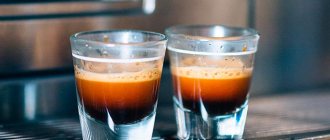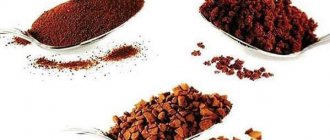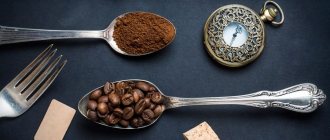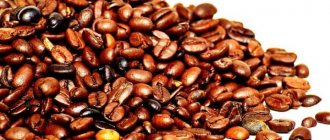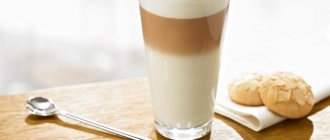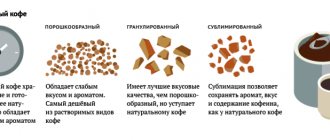Milk is the most popular additive in coffee. Most people prefer milk coffee drinks, as they are milder in taste and do not feel the bitterness or sourness of coffee. Any coffee shop has a huge selection of coffee and milk-based drinks, much more than pure black drink. Milk is poured hot and cold, whipped, and foam is made. Some add sugar, but most avoid it and drink their drinks as they are served. For those who control their diet, it is important to know the calorie content of coffee with milk without sugar.
How many calories are in coffee with milk without sugar?
There is no single exact number. Much depends on the volume and quality of the dairy product, and to a lesser extent on coffee. Coffee beans contain almost no calories, and the fats and sugars present are baked in when roasted. Soluble granules have a higher energy value, but they also cannot affect overall caloric intake as much as dairy products. Therefore, first we will consider the calorie content of milk of all types and types of fat content.
According to the standard, energy values are written on packages per 100 ml, but most people add about a tablespoon per cup (for a medium cup) or about 2.5 tablespoons for a large mug. You can use this data as a guide, or calculate exactly how much milk you pour into your favorite drink.
Calorie table for different types of milk
| Type of milk | Calories per 100 grams | Calories per 20 ml serving (tablespoon) | Calories per 50 ml (2.5 tablespoons) serving |
| Fat content 0.1% | 31 | 6 | 16 |
| Fat content 0.5% | 36 | 7 | 18 |
| Fat content 1.5% | 44 | 9 | 22 |
| Fat content 2.5% | 52 | 10 | 26 |
| Fat content 3.2% | 58 | 12 | 29 |
| Fat content 3.5% | 61 | 12 | 31 |
| Domestic cow | 64 | 13 | 32 |
| Dry whole | 476 | 95 | 238 |
| Dry low fat | 350 | 70 | 175 |
| Soy 0.1% | 28 | 6 | 14 |
| Soy 0.6% | 43 | 9 | 22 |
| Condensed without sugar | 75 | 15 | 38 |
How many calories are in one cup of ground coffee?
It's very simple - the answer depends on the type of coffee drink. Take, for example, espresso, which is usually brewed from freshly ground coffee. Classic espresso is 7-10 grams of product per approximately 30 grams of water. Thus, a cup of espresso without milk and sugar will add 14 to 20 kilocalories to your body.
Fans of double espresso (doppio), which is essentially the same espresso, only with double the amount of water and coffee (that is, approximately 60 grams of water per 14-20 grams of coffee), consume from 28 with one serving of the drink without additives up to 40 kilocalories.
Americano is a coffee drink for those who do not like a very concentrated coffee taste. Essentially, an Americano is a highly diluted espresso or double espresso. Moreover, according to the classic preparation, it can be diluted in almost half a liter of water. Thus, the calorie content of one cup of classic Americano made from ground coffee is the same 14-20 kilocalories.
Calorie content of natural coffee with milk without sugar
Coffee beans have a low energy value - on average, 2-4 kcal per 200 ml of finished drink. If you add milk from a carton or tetra-pack, add 2-4 calories per serving of dairy product and you will get a fairly accurate number.
Example: we brew 200 ml of coffee in a Turk, this is 4 calories. And add 50 ml of milk with 1.5% fat - that’s another 22 kcal. A 250 ml cup of drink produces 26 kcal.
The difference of +/- 5 calories for one drink made from natural grains does not play a role in a daily diet of 1500-2000 kcal.
But quite often we drink coffee with milk in coffee shops, in the form of ready-made drinks, and the amount of milk in them varies. As a rule, coffee shops purchase milk with a fat content of at least 3%, and more often - 3.2% or 3.5%. It produces an elastic, durable foam of a pleasant color that holds well. The foam from a low-fat or medium-fat product is often grayish and falls off quickly. 3.5% milk gives a delicate, creamy taste, and it is usually chosen for coffee shops, also used for those drinks where the milk does not need to be frothed.
Vitamins and minerals
As we found out, the calorie content of coffee is extremely low. But this drink is considered healthy, as it contains important minerals and trace elements that our body needs. Of course, he gets them from other sources, but drinking coffee is usually healthier than not drinking coffee (if you do it in reasonable quantities).
Scientists believe that 2 cups of coffee a day is beneficial for all adults.
Here is a table of the main elements contained in a 100 ml cup of black coffee:
| Milligram | RSP | Benefit | |
| Calcium | 5 | 1% | Strengthens bones, teeth, nails |
| Magnesium | 7 | 2% | Important for heart function |
| Phosphorus | 7 | 1% | For the formation of bones, teeth and nerve cells |
| Potassium | 116 | 3% | Good for muscles |
| Zinc | 0,5 | For healthy skin and hair | |
| Manganese | 0,1 | 3% | For cell development and iron absorption |
| B5, pantothenic acid | 0,6 | 6% | Anti-stress vitamin |
| B2, riboflavin | 0,2 | 11% | For health and beauty |
| B3, niacin | 0,5 | 2% | Particularly beneficial for the skin |
The type of water used in preparation (hard or soft) can affect the micronutrient content of a cup of black coffee, especially in relation to calcium and magnesium levels.
Antioxidants
By and large, antioxidants are important for us to improve our overall well-being and the body’s ability to absorb and properly use beneficial substances. Coffee is rich in antioxidants, and the lighter the roast, the more of them, which is why green beans are considered so beneficial.
Depending on the degree of roasting, one cup can contain from 80 to 320 mg of an important antioxidant - chlorogenic acid.
Chlorogenic acids help improve metabolism, establish intercellular metabolism, and also promote weight loss. Researchers say coffee contains 500 times more antioxidants than vitamin C.
Types of coffee drinks: how much milk and calories they contain
As a rule, milk coffee drinks are prepared on the basis of espresso, single or double. Different chains have their own recipes and volumes of the drink, and therefore the calorie content. The table below presents popular drinks from well-known chain establishments.
| Name of chain and type of drink | A portion | Calorie content |
| Coffeemania Cappuccino | 330 | 90 |
| Coffeemania Cappuccino | 450 | 160 |
| Coffeemania Latte | 330 | 156 |
| Coffeemania Latte | 450 | 218 |
| Coffeemania Flat White | 430 | 130 |
| CoffeeHouse Double Cappuccino | 100 | 64 |
| CoffeeHouse Latte | 100 | 44 |
| Chocolate Cappuccino | 100 | 35 |
| Chocolate Latte | 400 | 220 |
| Chocolate Cappuccino Light | 320 | 125 |
| Starbucks Cappuccino Grande | 350 | 140 |
| Starbucks Latte Grande | 350 | 220 |
| Starbucks Latte low fat | 350 | 112 |
| Starbucks Cappuccino low fat | 100 | 20 |
| McDonalds Cappuccino | 300 | 123 |
| McDonalds Latte | 300 | 132 |
Nutritional value of popular types of coffee
We've looked at black coffee, but not all of us drink it that way. Women who watch their weight often think about caloric intake, and they just like drinks with at least milk, and even sugar or sweeteners.
Here is a table of the nutritional value of coffee:
| Volume | Kcal | Fats | Squirrels | Carbohydrates | |
| Coffee with skim milk | 240 | 8 | 0,2 | 0,4 | 1,3 |
| Coffee with sugar | 240 | 38 | 0,2 | 0,2 | 9,5 |
| McDonald's, small Cappuccino | 200 | 59 | 3 | 3 | 5 |
| McDonald's, average Cappuccino | 300 | 86 | 4 | 5 | 8 |
| McDonald's, small Latte | 200 | 75 | 4 | 4 | 7 |
| McDonald's, medium latte | 300 | 118 | 6 | 6 | 10 |
| chocolate maker, latte | 400 | 219 | 8,7 | 8 | 26,7 |
| Chocolate girl, Raf | 400 | 345 | 23,6 | 6,7 | 25,3 |
| Chocolate girl, Cappuccino light | 320 | 84 | 1,5 | 6,3 | 10,8 |
| Chocolate girl, Cappuccino | 320 | 144 | 8 | 7 | 11 |
| CoffeeHouse, Mocha | 220 | 131 | 5,8 | 4,7 | 15,2 |
| CoffeeHouse, Latte | 220 | 89 | 4,8 | 4,5 | 7 |
| CoffeeHouse, Cappuccino | 350 | 121 | 5,5 | 6,2 | 10,6 |
| 3 in 1 Nescafe | bag | 67 | 2 | 0,2 | 12 |
The calorie content of the drink increases noticeably if milk is added to it. The coffee cocktails you get in cafes contain quite a lot of milk, and the larger the drink, the more calories (protein, fat and carbohydrates) you get.
When you pour some milk into your cup at home, the amount is rarely more than 50ml and has fewer calories.
If you control calories and strive to consume less, it is better to order an Americano with milk at a cafe, rather than a cappuccino, or, especially, a latte.
Calorie content of instant coffee with milk without sugar
Instant granules themselves are much higher in calories than natural grains. The fact is that during their production, only 15-20% of natural grain remains, the rest are emulsifiers, thickeners, dyes, stabilizers, impurities and the like. The taste also changes noticeably. And that's why most people add more dairy to instant coffee than to natural coffee to remove the chemical tastes of bitterness or acidity.
If you use powdered milk, keep in mind that it significantly increases the calorie content! 70-90 kcal in one tablespoon!
On average, we can assume that one teaspoon of soluble granules or powder contains about 10 calories. Some manufacturers have 4-5 (Nescafe), some have about 20 (Tchibo). You can find the exact information on the packaging, but if this is not possible, calculate based on 10 kcal per serving. Add to this the amount of milk product that you add - for a large mug it will be about 50 ml, for a small one - about 20.
Example: you prepare 250 ml of Carte Noire, add 2 heaped teaspoons, you get about 20 grams of granules, that is, about 20 calories. And add 50 ml of milk 2.5% fat - another 26 calories. In 300 ml of the finished drink you have 46 kcal.
Is it healthy to drink coffee without sugar?
Caffeine stimulates the nervous system, increases the tone of skeletal muscles and improves the psycho-emotional state. Under the influence of the active substance, the work of the heart muscle accelerates, which increases blood pressure. Coffee stimulates the central nervous system, increasing cognitive function due to improved blood supply to neurons. Caffeine increases a person’s performance and motor activity, sharpens attention and reflexes.
Caffeine has the following effects on the body:
- Suppresses the activity of carcinogenic substances. As a result, the risk of developing malignant tumors is reduced and the likelihood of cancerous degeneration of cells decreases.
- The condition of the circulatory system improves, the elasticity of the vascular walls increases. As a result, the development of atherosclerosis slows down and cholesterol plaques stop forming.
- Thanks to its tonic effect, coffee helps reduce the likelihood of diseases of the musculoskeletal system and neurological disorders: Parkinson's disease, Alzheimer's disease, muscular dystrophy.
- Caffeine has a positive effect on the reproductive system. In men, blood supply to the genital organs improves, the risk of erectile dysfunction decreases, and sperm motility improves. In women, the tone of the uterus increases.
Conclusions:
- Dairy products contain 1.5-3.5% fat - 10-12 kcal per tablespoon. A natural drink has about 4 kcal per 200 ml, and instant coffee has about 10. It’s easy to calculate the average calorie content.
- In coffee shops, a latte has more calories than a cappuccino, because milk with at least 3% fat content is used, and a latte has more of it.
- The more dairy product (milk, foam) in a cup, the more calories you will get.
- If you prefer natural coffee, you don’t have to count calories per cup - there are no more than 4-6, which is almost insignificant for the overall diet.
Useful properties and indications
Contrary to popular belief that coffee with milk is extremely harmful, it also has beneficial properties. These include:
- Tonic effect. Due to the high caffeine content in the drink, it stimulates the nervous system, promotes concentration, and relieves symptoms of apathy and drowsiness.
- Favorable effect on the gastrointestinal tract. Coffee with milk helps speed up digestive processes and improve the functioning of the stomach and intestines.
- Prevention of various diseases. Regular consumption of the drink helps reduce the risk of developing pathologies such as myocardial infarction, type 2 diabetes, Parkinson's disease, Alzheimer's disease and some others.
The drink has a beneficial effect due to its rich composition. 100 g of coffee with milk and sugar contains 4 daily carbohydrates, 2 fats and 3 protein. Also includes:
- Vitamins: B, A, C.
- Milk fat.
- Antioxidants
- Microelements: calcium, iodine, sodium, magnesium, phosphorus.
The properties and taste of the drink also depend on the method of its preparation. In addition to instant coffee, the following are deservedly popular:
- Latte. It is prepared from natural beans with the addition of frothed milk, which should be 3 times more than coffee.
- Cappuccino. This drink, on the contrary, contains 3 times more coffee than milk.
- Macchiato. A three-layer drink consisting of milk, coffee and foam.
The most useful option is considered to be one that contains more milk, because black coffee helps remove calcium from the body, and milk is the main source of this microelement.


